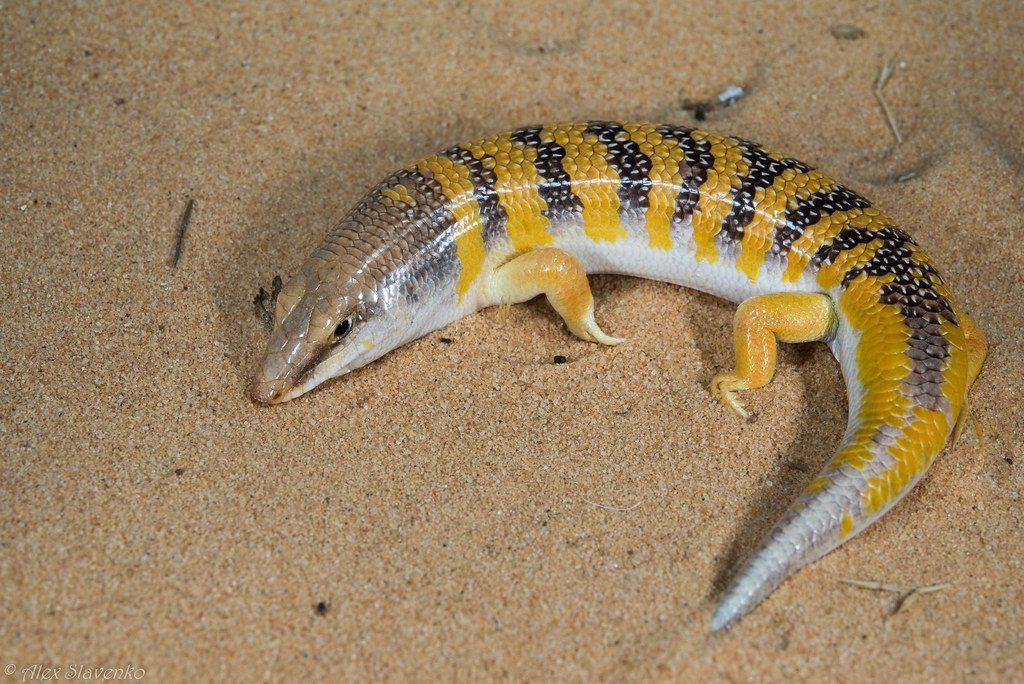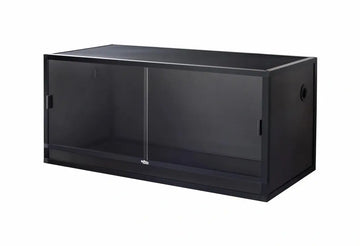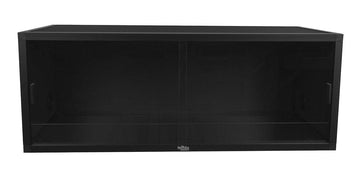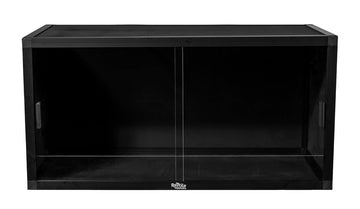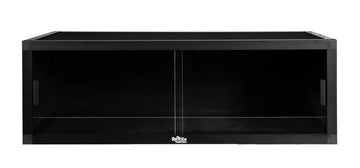The sandfish skink (Scincus scincus) is a 6-8” long, diurnal, fossorial lizard native to the Sahara desert and the Arabian peninsula. They prefer arid habitats with sand dunes and sparse vegetation.
Sandfish skinks have a steeply tapered head, small black eyes, countersunk jaw, robust body, short limbs, short digits, smooth scales, and a thick tapered tail. Coloring and pattern varies based on subspecies. One of the most distinctive features about this skink is their feathery toes, which help them “swim” through loose sand.
Sandfish skinks are an intermediate-level pet reptile. With proper care, they can live up to 10 years.
Minimum terrarium size for sandfish skinks
The minimum terrarium size for a sandfish is 30”L x 12”W x 12”H, or a 20 gallon “long” tank. Of course, larger is always better — if you provide, they will use it!
Housing multiple sandfish together is not recommended.
Do sandfish skinks need UVB?
Sandfish are diurnal, so they need high-quality UVB lighting as part of their setup. UVB lighting helps provide a clear day/night cycle, provides all of the vitamin D that your skink needs, strengthens the immune system, facilitates better digestion, and other benefits.
The best UVB bulbs for sandfish skinks are:
- Arcadia ShadeDweller kit
- Zoo Med T5 HO Reptisun 5.0
For best results, house the UVB bulb in a reflective fixture by Arcadia or Vivarium Electronics. The bulb should be roughly half the length of the enclosure. Mount this lamp 8-10” above the basking surface if over mesh, and if not, then it should be 10-14” above the basking surface.
UVB is blocked by glass and plastic, so placing the terrarium in front of a window isn’t “free UVB” — in fact it can make your terrarium too hot due to the greenhouse effect. Don’t forget to replace your bulb every 12 months!
Sandfish skinks are likely to benefit from bright grow lights as part of their environment. Add a full-length ~6500K LED or T5 HO fluorescent grow lamp to provide extra illumination.
Lights should be on for 13 hours/day during summer and 11 hours/day during winter. This should be done gradually to simulate seasonal changes in day length, and helps regulate your skink’s hormonal rhythm for better health.
Best temperature for sandfish skinks
Sandfish should have a basking surface temperature of 130-140°F and cool side temperature around 80°F. Heat sources should be turned off at night. Place a digital probe thermometer on the cool side of the enclosure to make sure it never gets too warm, and use an infrared temperature gun to check the temperature of the sand directly under the heat lamp.
It’s best to provide heat for your skink with a halogen flood heat bulb. Heat bulbs (especially halogens) are better at imitating sunlight, and considered to be a superior form of reptile heating by experts. The heat lamp should be placed on one side of the enclosure. If the heat lamp is too warm, dim it with a plug-in lamp dimmer. If too cool, you need a higher-wattage bulb.
Do not use ceramic heat emitters (CHEs), red bulbs, or blue bulbs, as these are not as effective.
Best humidity levels for sandfish skinks
Sandfish do best in an environment with average humidity below 50%, as measured by a digital probe hygrometer with the probe in the middle of the terrarium. However, they also need access to a humid retreat to give them a place to go when they need more moisture, such as when they’re shedding. The easiest way to provide this for your skink is by wetting down a section of the cool zone with water and placing a thin, flat rock on top to trap moisture.
Best substrate for sandfish skinks
Sandfish skinks need a layer of substrate at least 4” deep so they can dig and burrow, which is a natural behavior for them. The best substrates for sandfish include:
- Zoo Med ReptiSand
- Exo Terra Desert Sand
To keep the substrate clean and your lizard healthy, remove old food and waste every day, along with contaminated substrate. Using a sand scoop can be very helpful. But you will need to completely remove and replace your substrate every 3-4 months.
How to decorate a sandfish skink terrarium
A barren terrarium is boring to look at and stressful for your lizard to live in. Make the most of your terrarium by adding a variety of enrichment items for your pet to investigate and explore. Here are some ideas:
- logs/branches
- caves
- live or artificial plants
For best results, cover three sides of the enclosure to help your pet feel more secure in its home.
What to feed to a sandfish skink
Sandfish are insectivorous, which means that they eat mostly insects and other invertebrates. Here’s a basic feeding schedule for your pet sandfish:
- Hatchlings (under 3” long) — 2x daily
- Juveniles (3-5” long) — daily
- Adults (at least 5” long) — every other day
Variety is the key to providing a healthy, balanced diet for your sandfish. The more variety you can provide, the better!
Feeder insect options for sandfish skinks: dubias, discoids, red runners, crickets, black soldier fly larvae, mealworms, darkling beetles
Supplements
You will also need calcium and vitamin supplements to help keep your skink healthy. We recommend Repashy Calcium Plus LoD, lightly dusted on all feeder insects. It’s okay to occasionally skip a dusting.
Water
Of course, don’t forget a small water bowl for your skink to drink from! Change the water daily and scrub the bowl with a reptile-safe disinfectant weekly, or whenever it becomes soiled.
How to handle your sandfish skink
Reptiles generally don’t appreciate petting and handling in the same way that dogs and cats do, and this is particularly true for sandfish. Instead of trying to pick up and hold your sandfish (they’re very fast and slippery!), drop one bug into the enclosure at a time and watch them ambush their prey!
*This care sheet contains only very basic information. Although it’s a good introduction, please further your research with high-quality sources. The more you know, the better you will be able to care for your pet! We recommend the following sources:
"Scincus scincus" by alexslavenko is licensed under CC BY-NC-SA 2.0

